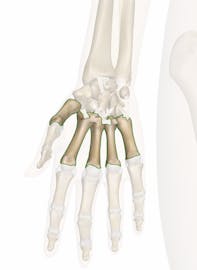The Metacarpals
Explore the anatomy and function of the metacarpals with Innerbody's interactive 3D model.

The metacarpal bones are a group of five long bones found in the palm of each hand. These bones support the structures of the hand and provide flexibility to the hand so that it can bend and stretch. The metacarpals also support the muscles that allow the hand to move the fingers and grasp a variety of objects.
Anatomy
The metacarpal bones are five long bones located in the palm between the carpals of the wrist and the phalanges of the fingers. They are classified as long bones as they are considerably longer than they are wide. The metacarpals are numbered first to fifth, with the first metacarpal connecting to the thumb and the fifth metacarpal connecting to the little finger.
Each metacarpal begins at the carpal end with a widened area known as the base. The base forms the carpometacarpal joint with the neighboring carpals. From the base, the metacarpal narrows slightly as it extends distally across the palm. Near the fingers, the metacarpal widens into a rounded prominence known as the head. The head forms the rounded structures that protrude when the hand is clenched into a fist.
Physiology
The metacarpal bones play several key roles in supporting the hand’s structures. They form the only hard tissue in the palm and give the palm a rigid structure.
Another important function of the metacarpal bones is the formation of the carpometacarpal joints with the carpals and the metacarpophalangeal joints with the phalanges. Carpometacarpal joints permit the hand to flex, extend, abduct, and adduct at the wrist. The first carpometacarpal joint is a particularly unique saddle joint that provides extra mobility to the first metacarpal and, by extension, the thumb. At all metacarpophalangeal joints, the phalanges can flex, extend, abduct, and adduct to give the fingers a full range of motion.
Several important muscles attach to the metacarpals. The dorsal and palmar interossei muscles that move the fingers have origins on the metacarpals. Insertions for the extensor carpi radialis longus, extensor carpi radialis brevis, and the extensor carpi ulnaris allow these muscles to extend the hand at the wrist. The opponens pollicis muscle inserts on the first metacarpal to oppose the thumb while the opponens digiti minimi inserts on the fifth metacarpal to oppose the little finger. Finally, the adductor pollicis longus inserts on the second and third metacarpals to adduct the thumb.



